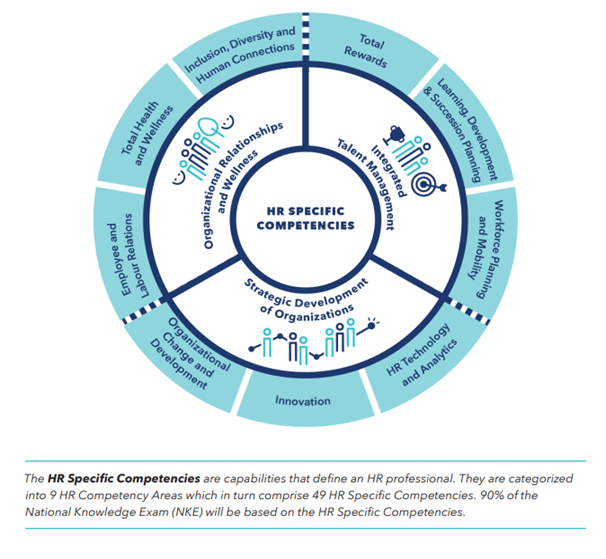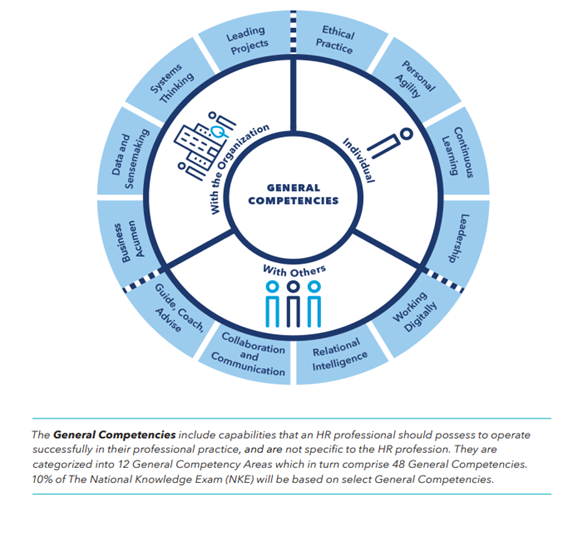
CPHR Canada's Updated Competency Framework: What Changed and How it Affects Members
27
Jul 2023
526

Author:
Erica Blain, Director, Professional Standards, Registrar, CPHR Alberta
In late 2021, CPHR Canada announced the introduction of an updated Competency Framework for the HR profession. Many members have reached out with questions on what was updated, why and how it affects them on the path to the designation or in mainiting their designation. The CPHR Alberta Professional Standards team, has put together this blog to answer some of the most frequently asked questions!
How was it updated and why?
In many ways, the competency framework has remained much the same but with some key changes to ensure that the CPHR designation remains relevant and topical in today’s changing world. Human Resources is a field that has grown, expanded and diversified over many years since it’s inception as a profession. CPHR Canada worked closely with HR professionals across Canada to amend the framework so that it is in-line with the working world today and in the near future.
The updated Competency Framework recognizes that there is no longer an ideal role, position or way of functioning for the HR Professional, instead, providing a strategic approach that matches the pace of change. Human Resources has such a broad scope and it is becoming more valued in organizations every day. By updating the Competency Framework, we are keeping up with the growth and progression of the profession as a whole and trying to incorporate all professionals within the field.


What has changed?
While the changes to the Competency Framework were not sweeping, you will see some smaller amendments. One update is the introduction of the competency entitled Innovation. Especially through the pandemic, HR professionals were forced to be agile and innovative to continue to do their roles but in a changing environment and continuous legislation or safety protocol updates. The demand on HR to innovate and be adaptable has become more vital than ever and is an important area of focus.
Additionally, you’ll see what used to be just “engagement” is now Inclusion, Diversity and Human Connection. Again, in the past few years we have seen an increased call for employers to ensure an inclusive environment is provided to all employees. Also, diversity is an active goal for many organizations and is better recognized, appreciated, and celebrated. CPHR Canada wanted to ensure that these important concepts were incorporated into the Competency Framework because they are so valued by employees and employers alike.
Another change was to remove the competency area Professional Practice. This competency focused on legislation and ethics, having business acumen and leadership skills. These skills are now incorporated within the newly introduced General Competencies instead.
In the previous Competency Framework, there were enabling competencies which incorporated a diverse set of skills into five loosely related areas. With the new framework, the scope has been broadened but also refined into twelve non-HR competencies, which are termed General Competencies.
The overall result of these changes led to the establishment of HR Competencies that are more specific to the work of today’s HR professional. The separation of competencies into HR-Specific Competencies and General Competencies helps the field move beyond the silos of “functional” HR areas, which results in the structure of the new framework being more strategic and integrative. These enhancements showcase the greater breadth of the practice of HR and reflect how the evolution of the professional is playing out in workplaces across Canada.
How do the changes affect members?
For members looking to write the National Knowledge Exam, the exam is based upon this updated Competency Framework. The General Competencies are covered lightly on the exam, making up just 10% of the questions. The other nine competencies are each covered with 10% of the exam.
The framework is also the foundation for those going through the Experience Validation Assessment. Candidates for the CPHR designation will need to show that they have proficiency in a variety of competencies in order to be successful on the experience assessment and gain the CPHR designation.
For members who already have their CPHR designation, this only affects them as they complete their Continuing Professional Development (CPD) requirements. In order for activities to count towards the CPD requirement, the activities need to be linked to at least one area of the Competency Framework. Because the framework is extensive and clear, it is quite simple for Chartered Members to ensure their CPD requirements fall into these categories.
The framework really covers everything HR so using the framework as a foundation for further learning or education is a great way to better yourself professionally. If you are looking for ways to expand your knowledge or if you want insight into which areas you require further information or training, looking at the competencies is a great starting point as it outlines what HR professionals should know in order to be the best they can be for their employees and organization as a whole.
The views and opinions expressed in this blog post belong solely to the original author(s) and do not necessarily represent the views and opinions of CPHR Alberta.

Author: Ada Tai, MBA, CPHR, SHRM-SCP After publishing “ A Strategic Guide to Organization Restructuring, Part 1 ,” I heard a consistent follow-up question from leaders: “How do you actually re-design an organizational structure so it aligns with strategy, future needs, and the realities of the day-to-day operations?” In this post, I will take you behind the scenes of a recent restructuring project our firm completed and walk you through the steps for designing a structure that works not just today, but also for the next 3 - 5 years. Step One: Understand the Organization Restructuring is not a mechanical exercise. Before anyone touches boxes on an org. chart, leaders must understand the full context of the organization: its challenges, aspirations, constraints, and people. Recently, our team worked with a large public-sector entity that hadn’t reviewed its structure in more than a decade. Over time, several issues had emerged: Long-standing role ambiguity and workflow friction Significant retention and succession challenges A rapidly growing industry and expanding service demands A CEO overwhelmed with too many direct reports Insufficient leadership depth in the layer immediately below the CEO The mandate was clear: Design a structure that could carry the organization for the next 3–5 years. Before jumping in, we partnered with the executive team to answer a set of foundational questions: Why is a new structure needed now? What pressures, risks, or opportunities are driving the change? What is the organization trying to achieve long-term? We reviewed vision, mission, values, strategic priorities, and expected growth. How is the organization currently designed? We examined complexity, formality, decision flows, span of control, talent mix, communication channels, policies, and people challenges. What work must happen to deliver services successfully? We mapped critical processes and clarified who is responsible for what work today and tomorrow. What resources and budget constraints shape the options? We did a reality check. Answering these questions transforms guesswork into a strategic foundation. Step Two: Plan for the Structure Review Once aligned on objectives and constraints, we co-created a plan for the whole structure review. 1. A small project team was assembled within the organization. This was a group of leaders/champions who would serve as our partners, sounding board, and communication anchors throughout the process. 2. To design a structure that reflects reality rather than assumptions, we needed both qualitative and quantitative insights. Together with the project team, we developed a data-collection plan that included: On-site tours to understand operations and workflow in context In-person interviews with employees across departments, tenure levels, roles, and demographic groups Review of organizational documents , including strategy, service data, operational metrics, etc. 3. We also conducted external research to understand the demand for the organization’s services, the competitive landscape, and industry benchmarks. The goal was to build a complete, nuanced picture of how work actually gets done. Step Three: Design the Structure Over the next several weeks, we conducted interviews with 80% of the head office staff and 60% of the frontline workforce. One important message we emphasized to every group is: “This review is not a performance assessment, nor an attempt to eliminate jobs. It is about building a structure that sets everyone up for success.” Gradually, as we gained insights, a clear picture emerged of what the future structure could and should be. We facilitated a series of structural design sessions with the project team. These sessions were collaborative, candid, and grounded in both data and lived experience. Together, we co-created: A transition structure for the upcoming year — providing stability while preparing for change. A future-state, growth-oriented structure designed for the next 3 – 5 years — with more substantial leadership depth, transparent accountability, and defined pathways for talent development and succession. The result was not just an org. chart. It was a blueprint for how the organization would operate, make decisions, support employees, and deliver services at a higher level. Step Four: Support the People Side of Change Even the best-designed structure can fall apart without thoughtful implementation. Once the project team felt confident in the proposed structures, the next steps were: Securing Board approval Preparing a comprehensive communication plan Engaging employees with clarity, empathy, and transparency We had the privilege of presenting the new design and its rationale to the Board. After approval, we supported the organization as it rolled out the change to staff, ensuring leaders were prepared to answer questions, set expectations, and guide their teams through the transition. Structure isn’t just architecture; it impacts morale, trust, and people’s sense of security. The human side must be handled with the same care as the technical side. Final Thoughts Restructuring is a strategic redesign of how an organization works, leads, and delivers value. A thoughtful structure review requires three things: Deep understanding of the organization’s reality Collaborative design grounded in data Careful implementation that supports people When these pieces come together, restructuring becomes more than a response to pressure. It is an opportunity to strengthen leadership capacity, improve clarity and accountability, and position the organization for sustainable growth. Check out my previous blog: “ A Strategic Guide to Organization Restructuring, Part 1 ”

Alberta’s labour market is dynamic, and HR professionals need timely insights and practical tools to make informed decisions. To help you navigate hiring trends, funding opportunities, and compliance requirements, here are three key resources you should know about: 1. Labour Market Information Bulletin The Regional Employer Supports Bulletin provides a snapshot of Alberta’s labour market, including: Employment Trends: September saw a 1.7% increase in employment , reversing previous declines. Unemployment Rate: Currently at 7.8% , slightly above the national average. Wage Updates: Average weekly wages rose to $1,433.62 . Upcoming Webinars: Topics include hiring foreign workers, employment standards, and psychological health and safety. Explore Labour Market Notes 2. Hiring Demand Bulletin The September Hiring Demand Bulletin offers detailed insights into job postings and hiring patterns: Job Postings: Over 30,500 new openings in September, with Calgary and Edmonton leading the way. Top Occupations: Retail salespersons, cooks, registered nurses, and material handlers. Sector Trends: Sales and service roles dominate (31%), followed by trades and transport. Regional Highlights: Calgary posted 11,004 openings , Edmonton 10,032 . View full hiring demand details 3. Employer Resources Guide Looking for ways to attract, train, and retain talent ? The Employer Resources Guide is packed with programs and funding opportunities: Grants & Funding: Canada-Alberta Productivity Grant – supports training to boost productivity. Workforce Strategies Grant – funds innovative workforce development solutions. Industry-Specific Programs: Food Futures Program – wage subsidies for food industry placements. ECO Canada – training and wage subsidies for environmental jobs. Youth & Apprenticeship Incentives: CAREERS Internship Programs – up to $7,500 for hiring youth. Student Work Placement Program – funding for co-op and internship positions. Recruitment Tools: Job Bank – free job posting platform. Agriculture Job Connector – match workers with agri-food employers. Access the full Employer Resources Guide Why These Resources Matter Together, these tools help HR professionals: Plan strategically with accurate labour market data. Fill critical roles by understanding hiring trends. Leverage funding to reduce recruitment and training costs. Stay compliant with employment standards and best practices. Take Action Today: Register for upcoming webinars on employment standards and workforce programs. Connect with a Workforce Consultant for tailored advice. Bookmark these resources to keep your HR strategies future-ready.



